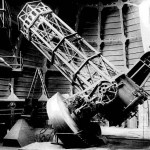mirror
The Ambassadors, 1533
Hans Holbein the Younger
In the artistic technique called anamorphosis, an object is depicted in distorted perspective, so that the viewer has to take special action, like looking from a specific angle, to see the "correct" image.
The most famous example of anamorphic painting is Hans Holbein's The Ambassadors (1533), a double portrait in which the illusion of highly detailed reality is fractured by a blurred grey streak superimposed across the painting's bottom third. If one stands at an acute angle, close to the painting, the blurred streak resolves itself into a…
In the twilit waters of the deep ocean, beneath about 1000m of water, swims the brownsnout spookfish (Dolichopteryx longipes). Like many other deep-sea fish, the spookfish is adapted to make the most of what little light penetrates to these depths, but it does so with some of the strangest eyes in the animal kingdom.
For a start, each eye is split into two connected parts, so the animal looks like it actually has four. One half points upwards and gives the spookfish a view of the ocean above. The other points downwards into the abyss below and it's this half that makes the spookfish unique.…
I was doing a little research into the history of telescopes, and it was about a century ago that they finally realized how much more potential light-gathering power reflecting telescopes had as compared to the older refracting telescopes. On Mt. Wilson in California, astronomer George Ellery Hale and optician George Willis Ritchey (back then everybody was named George -- look it up!) were embarking on a program to build large reflecting telescopes as the wave-of-the-future of Astronomy.
But even before this telescope was operational, Hale and Ritchey were thinking of bigger and bigger…

